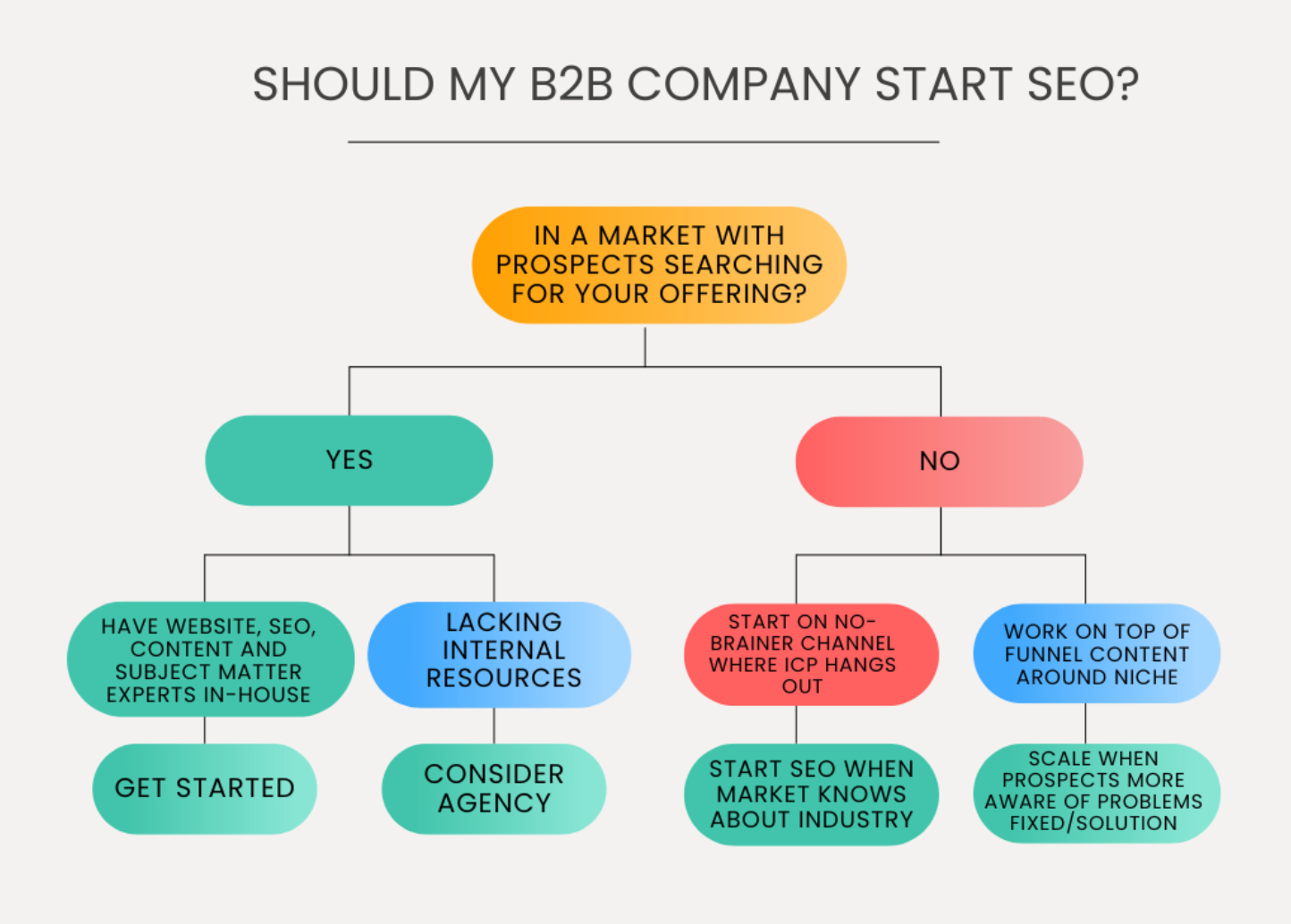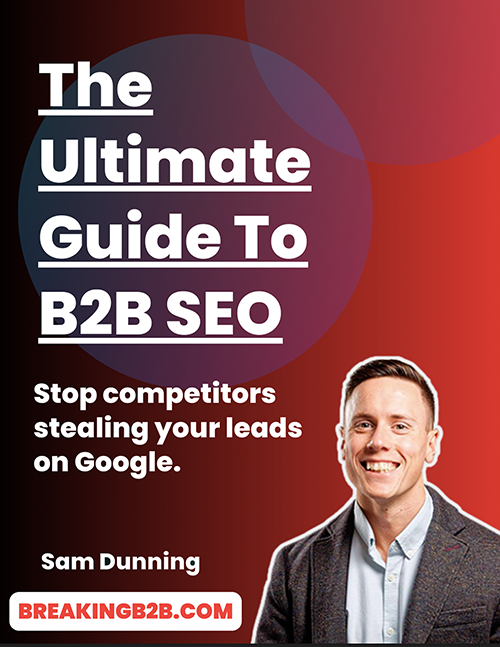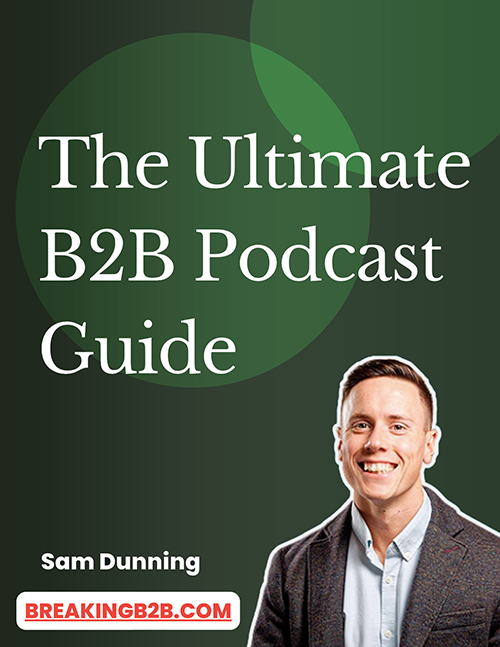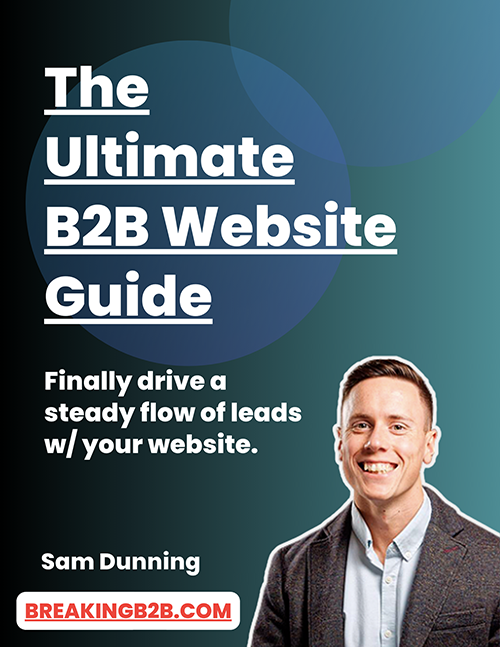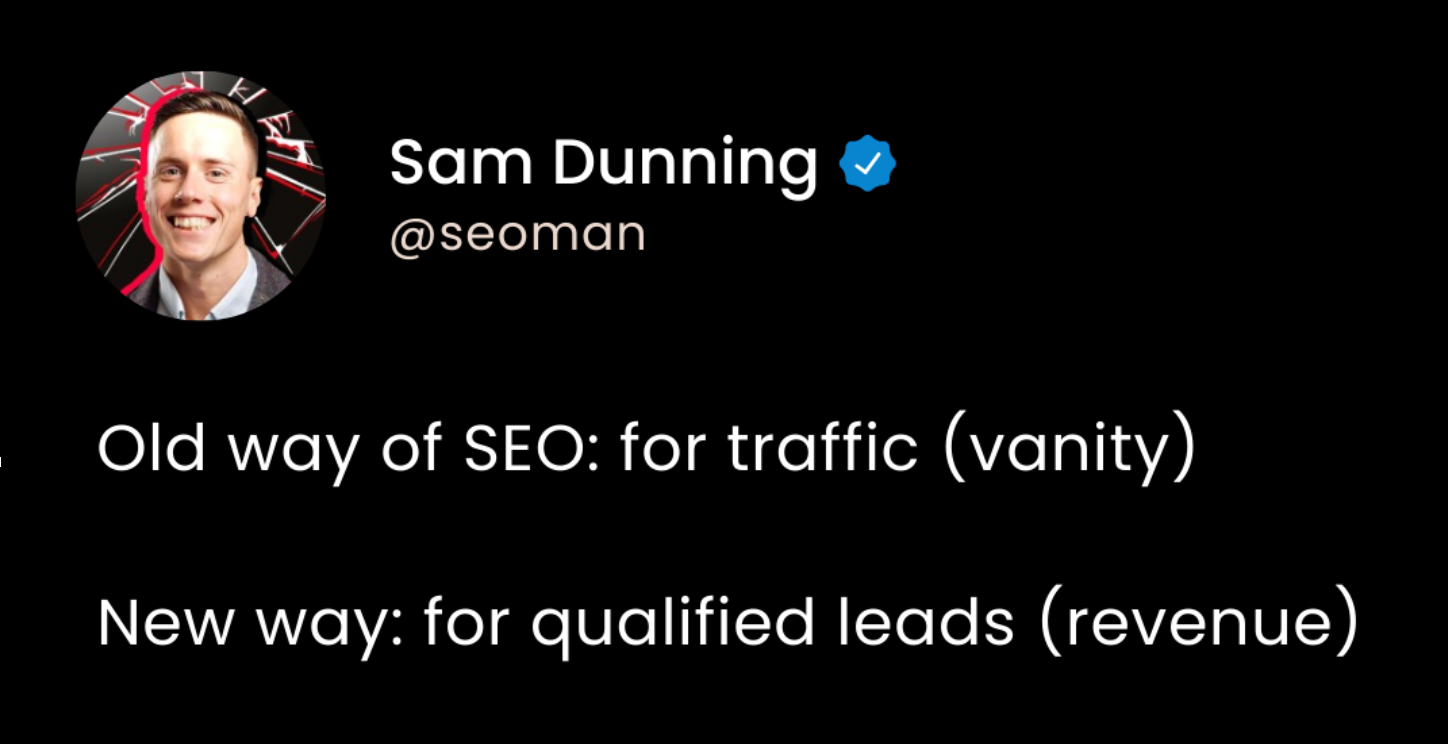Ultimate B2B SEO Guide
Stop competitors from stealing your inbound on Google.
Author: Sam Dunning ✪ Date: March 15th 2024
I've put together a B2B SEO guide to help your
B2B SaaS, Service, or Tech company boost revenue through the power of organic search, also known as SEO. Learn how to create a sustainable stream of leads, consultations, and demo requests for your team. Let's get to it then, here's your ultimate B2B SEO guide:
Common problems I see with B2B companies
1. Neglecting Organic SEO: Many B2B companies focus heavily on ads and outbound sales, disregarding the potential of organic SEO. This results in missing out on a significant portion of market demand and opportunities that could have been captured through Google searches.
2. Lack of Content on B2B Websites: Often, B2B websites have minimal content with only a few pages, limiting the information available to potential customers. This lack of comprehensive content can hinder the website's visibility and credibility.
3. Undervaluing SEO: Some companies fail to recognise the importance of SEO in driving organic traffic and generating leads. By not investing in SEO strategies, these companies are potentially losing out on valuable opportunities to reach a wider audience.
4. Pressure to Achieve Fast Revenue Targets: B2B companies are frequently under pressure from investors to quickly meet revenue targets. This focus on short-term gains can lead to overlooking the long-term benefits of implementing a well-rounded digital marketing strategy that includes SEO efforts.
Why invest in SEO?
It enables you to establish a lasting organic content ecosystem that consistently ranks on Google, generating inbound leads even while you sleep.
Crafting a robust SEO strategy casts a wide net on Google, establishing an organic inbound engine that positions you at the forefront whenever potential clients seek industry information or engage with sales.
If you takeaway anything from this B2B SEO guide, it should be that SEO boosts organic traffic and inbound leads, and it also minimises the need for excessive ad spending!
What you’ll need before investing in SEO?
Before investing in SEO, ensure you have a well-designed website that effectively attracts and engages your target audience. Your website should be optimised for both mobile and desktop users, with compelling messaging that resonates with your prospects' needs and goals.
Not sure if SEO is a good fit?
SEO is essential for SaaS companies looking to increase brand visibility and drive organic revenue growth. Unless you are in a brand new or highly niche market, investing in SEO is crucial for establishing a solid online presence & staying competitive online. It's a long-term strategy that yields great results. Once you've read my ultimate B2B SEO guide, feel free to reach out to me directly for help or advice specific to your B2B business.
There are a whole host of SEO tools (many of which are free), that you can use to help you get right to the top of the search results – And I’ve written whole article about them! >HERE! <
Keyword Research
Out with the old-school
IIt's time to revolutionise your approach to keyword research! Instead of solely relying on software and tools, tap into the invaluable insights of your ideal clients and prospects.
They are the ultimate source of power-packed search terms and content ideas. By engaging with them, you'll uncover their pressing questions, objections, and challenges.
This firsthand knowledge will enable you to speak their language and address their needs effectively. Collaborate with your sales team to compile a comprehensive list of common queries and obstacles.
For deeper insights, leverage tools like Gong to dissect sales calls and discover the hidden gems your customers are craving answers to. Boost your strategy by putting the customer at the centre of your keyword research efforts.
More traditional keyword research
After crafting your detailed list, it's time to do traditional keyword research (this compiled list will prove invaluable for long-tail keyword exploration and crafting targeted content, including FAQs that align with your prospects' search queries).
Kick off your keyword journey by focusing on high buying intent searches relevant to your offerings. For instance, if your niche is software for sales teams, target keywords like 'proposal software,' 'sales recording tools,' and 'buyer enablement software.' Remember, the long-tail keywords harbour hidden treasures.
The more tailored your keywords are to your niche and target audience, the greater the potential for inbound traffic.
Instead of grappling with the fiercely competitive 'CRM,' consider honing in on specific industry niches, such as 'CRM software for accounting.' Long-tail keywords expedite rankings and attract high-quality leads from your desired markets.
Some popular SEO keyword research tools include Semrush, Ahrefs, Google Keyword Planner, and Ubersuggest. Mastering keyword selection helps you unlock your website's potential
Other ideas for keyword research:
- Problem-based searches: Target keywords that address your audience's specific pain points or challenges.
- Get competitive: Compare your brand with competitors using search terms like '[your brand name] v [competitor]' to attract users in the decision-making stage.
- Answer burning questions: Optimise for queries like 'how to do X?' to capture users seeking solutions or information.
- Sales funnel coverage: Tailor keywords for each stage of the funnel - from learning and evaluating to searching for a solution.
- Alternative searches: Target terms like 'Calendly alternative' or 'Chili Piper alternative' to reach users comparing options in your industry.
- High-intent queries: Optimise for 'Best [offering] tool/company/software' to attract users actively seeking the top solutions in the market. These pages are usually listicles with more than 10 pages shown. It allows you to showcase the value of your offerings.
- Zero traffic searches: Capitalise on overlooked terms with no search volume but high intent, answering common questions or addressing your audience's specific problems. It’s a great way to attract quality leads, as you probably won't have any competitors.
On-Page SEO
On-page SEO refers to the optimisation efforts made directly on a website to improve its organic search engine rankings. This includes technical aspects like site structure and content optimisation. It aims to enhance visibility and relevance for specific keywords to attract more organic traffic.
Technical SEO
This usually begins with a comprehensive audit of your website, focusing on:
- Ensuring page speed is ideally 2 seconds or less
- Implementing key data tools such as SEO tools
- Setting up Google Analytics to track various metrics like traffic sources, organic traffic, and conversions
- Utilising Google My Business and Google Search Console for enhanced visibility
- Conducting a thorough competitive analysis to identify benchmarks and surpass them
- Revising meta-data (title tags, meta descriptions) on core SEO pages
- Developing SEO landing pages targeting key search terms
- Formulating an internal linking strategy and implementing Rich snippet/Schema
- Addressing on-page and technical issues like Keyword Cannibalisation (this is where several pages rank for the same keyword, and you’d rather have one ranking for the keyword).
- Optimising image file names, alt text, and title attributes on core SEO landing pages.
Website Content
In this stage, you create dedicated pages for each feature, target market, persona, use case, alternative, integration, etc., that potential customers may search for.
Focus on high buying intent search terms from keyword research and develop a page for each key offering that aligns with search intent.
There’s a simple strategy you can use to build pages on your website that rank.
Assess the top 3 organic search results related to your chosen search terms. By analysing these results, you can gain valuable insights into practical strategies for attracting potential customers.
Step 1:
Develop your service, product, or article page and tailor it to meet the needs and preferences of your target audience. Understanding your ideal client's concerns, challenges, objections, and aspirations allows you to create content that resonates with them.
Moreover, it's important to keep in mind Google's E-E-A-T update (Experience, Expertise, Authority, and Trust).
For instance, when crafting a detailed service or solution page, consider including an overview of the offering, common problems it addresses, reasons why it's essential, and processes with a video guide.
Also, include how-to guides, examples or case studies, pricing information, FAQs, and incorporate relevant social proof such as testimonials, videos, and reviews. Don’t forget to provide clear Calls to Action (CTAs) so your visitors can confidently move to the next step.
Remember, creating informative and engaging content is key to capturing the attention of potential clients and establishing credibility in your field.
Built a Page But it’s Not Ranking?
So, here's the deal: the issue could be that you're not quite hitting the mark with search intent. What even is search intent, you ask?
It's all about understanding what your potential customers are after when they hit that search button. Are they in research mode, hunting for answers or solutions, or trying to learn something new?
Or are they in money mode, comparing choices, ready to make a purchase, checking out the processes, or just looking to get a task done? It's all about knowing where they're at!
Let's say you want to rank for 'best meeting scheduling software', but the first page of Google is dominated by comparison articles – not an easy feat!
So, here's a smarter approach: Study the top 3 organic results. This analysis will guide you on whether to create an article, listicle, solution page, comparison page, or perhaps something unique.
Next, craft a standout page that outshines the competition. Back it up with customer insights to connect with potential customers and position your product as the ultimate choice.
This strategic process will boost your chances of climbing the search rankings and standing out in the crowded online space.
Step 2:
Create a solid design for both mobile and PC, incorporating essential technical SEO elements like meta titles, descriptions, image and heading tags, and relevant internal links.
Step 3:
Ensure to apply the process across all your money search terms and services. At Breaking B2B, we diligently utilised this strategy to surpass major SaaS giants like Salesforce and Webflow.
Recently, we replicated this success by achieving first-page rankings for 'B2B SEO Company' in the UK/EU and other key regions. Additionally, we secured a first-page spot for 'web development company' in those same regions.
Once you've exhausted the high-intent search terms of your target clients, craft blog articles that address their pressing issues and inquiries related to your core services.
Remember, your clients hold valuable insights that can shape your content. By addressing their needs, you're tapping into a pool of demand that's already established through conversations.
Quick Wins For B2B SaaS and Tech Companies
Finally Conquer SaaS SEO (drive a consistent flow of organic sign-ups & demos):
Nail these before doing random blog articles for fluffy traffic that won't convert.
Here's 5 keywords and page-flows that work a treat for SaaS.
1. Best [category] software
Typically a listicle format page. Aim to make a more comprehensive and helpful list than the current #1 spot results.
Add fair summaries of competitors. Put your brand first and a clear example of problem you fix, how you fix it and CTA.
Build these for each key variation of your offer and keyword that prospects might use e.g. software/tool etc.
2. Your brand vs competitor
Same process but this is more focused on yourself then your core competitors.
Build out for each main alternative.
3. Competitor alternatives
Similar process as one. The search intent again will likely be a listicle.
4. Best [Tool/software] for [industry]
Map out all the key industries you want to serve and that drive the most profitable clients.
Build out long-form pages for every key offer + industry.
5. How to [job to be done]?
The spiciest framework in SEO (dominate your category):
Jobs To Be Done (JTBD).
This framework could even be the spiciest for marketing in general.
JTBD in a nutshell:
It starts with customer interviews.
From people who have recently made a change (in your case who recently signed up)
Understanding not what they bought...
But why.
That point of realising they could no longer make progress if they stayed as they are.
They could no longer get the 'job' done.
That tipping point is your marketing gold.
How to use it to crush SEO:
From customer interviews you work out how they were getting the 'job' done before using your solution.
And the terrible thing (juicy, bleeding neck problem) that happened to prospects when they realised they needed to change.
Then you leverage that in your pages and articles.
- JTBD
- Problem with it
- What happens if you ignore it
- Position your offer as the solution
Keyword research:
When you know what prospects have used before they came to your solution...
You can target others with the same struggles searching on Google.
Let's imagine you provide a power dialler SaaS tool.
Your prospects might search: 'how to make faster cold calls with a cell phone'
On your article you follow the framework above.
Shining a light on the problem with manual dialling, impact (slow dials, less conversations and meetings) and solution (power dialler tool) with your article.
Off-page SEO
Off-page SEO involves all the strategies and tactics executed outside your website to boost its online visibility. This aspect becomes important when targeting competitive and generic keywords.
A powerful method to achieve this is through building backlinks. Google perceives backlinks as a testament to your site's credibility. Backlinks also boost your domain authority.
By leveraging backlinks effectively, your website can climb the ranks in Google's organic search results, even for challenging keywords.
Some ways to build backlinks
F
Free:
1// Podcasting
Step 1. Visit a reputable podcast ranking website like chartable.com and navigate to the 'charts' section.
Step 2. Select Apple as the platform and pick a country that aligns with your target audience.
Step 3. Pick a service category that you are knowledgeable about, such as 'marketing'.
Step 4. Explore the top 100 podcasts within the chosen category.
Step 5. Identify podcasts that are open to having guest appearances.
Step 6. Craft personalised outreach messages to the podcast hosts via email.
Step 7. Participate in an engaging podcast episode and subtly promote your brand towards the end.
Step 8. Politely request the host to include a backlink to your website on the podcast's article page post-release.
If you do this monthly, you can secure valuable backlinks and enhance your credibility among your target audience who are tuning in to industry-specific podcasts.
2// Outreach
Craft a standout article on your website.
Let's say your niche is CRM; consider creating a comprehensive piece like 'How to Choose the Best Finance CRM.'
After publishing, the next step is to search the topic on Google. Study the top-ranking pages on the first page of the search results. Your goal is to elevate your content above theirs by focusing on several key areas:
1. Demonstrate industry expertise.
2. Enhance content quality and quantity (aim for 10k+ words).
3. Incorporate unique stats and data.
4. Include visually appealing infographics.
5. Use video explainers.
6. Cover all aspects thoroughly.
7. Provide actionable insights.
8. Embrace the 'Skyscraper' technique, creating detailed articles of 10k words or more.
Once your epic article is ready, reach out to relevant companies and influencers mentioned in the guide for potential backlinks.
With time and a top-notch article, you can naturally attract backlinks from other sites referencing your work. This strategic approach sets the stage for organic link-building success.
3// Partnerships
Discover businesses within your industry that provide complementary services to yours.
For instance, if you operate a web design and SEO agency, consider collaborating with a company providing analytics software.
Join forces to create engaging content such as guides, how-tos, videos, or podcasts. By cross-promoting each other's content on your respective blogs, you not only strengthen business relationships but also boost your SEO efforts.
4// Guest articles
Numerous reputable websites welcome guest contributions within their industry.
To maximise your chances of success, seek out established sites that align with your field, review their submission guidelines, and propose valuable content.
An effective method is to search for "[your industry/keyword + write for us]" or "[your industry/keyword + guest article]."
Upon approval to contribute, these platforms typically permit you to include a backlink to your website in the 'featured author' section.
5// Use HARO sites
You can use sites like HelpAReporterOut[dot]com to stay updated on news and media stories. Connect with journalists by responding to their requests. If your response is selected, you could earn a valuable backlink from the news site.
Paid:
Buy backlinks from trusted editorial websites - it's a real thing! Partner with an agency or consultancy (ahem, like mine!) to handle your B2B SEO and link building efforts.
This way, you can devote your energy to expanding your business and converting the leads generated through SEO. Beware of cheap link building services promising the moon for a pittance.
These can lead to penalties and harm your search rankings. Additionally, boost your off-page SEO by getting your website listed on industry-relevant directories and citations that link back to your site.
Need further help building highly effective links for your SaaS business? — Checkout my detailed SaaS Link building Strategy guide
>
HERE!<
Using Video in SEO
Looking for an edge in SEO? Secure two prime spots on Google's results page with video content.
A clever tactic to dominate competitive keywords. Create a comprehensive YouTube video centred around your target search term. Then, embed this tailored video to your article or page.
These optimised pages tend to achieve higher rankings, with the added benefit of displaying a video thumbnail that boosts click-through rates.
As your page climbs the rankings, your video may also rank in the video section, eventually appearing in both the organic and video sections. This strategy has proven successful for several of our services.
Getting Stakeholder Buy-In For SEO
SEO can often be a challenging sell internally, but fear not! Here are three valuable tips to help you navigate through it successfully:
Tip 1: The C-Suite craves fast results.
While the impact of effective SEO on the inbound pipeline can be seen within just three months, this may not always be convincing enough for marketing and revenue leaders.
To win them over, tap into their pain points.
Here’s an example: Whenever a prospect searches for our solution, problems we solve, or compares us to competitors, our competitors come out on top, robbing us of potential leads.
By starting your SEO efforts sooner rather than later, you can unlock a sustainable flow of inbound traffic through organic search, especially if your sector or category is established and in demand.
Tip 2 (juicy):
Introducing the power of evergreen content - the SEO secret weapon that keeps on giving. Imagine your web pages and articles attracting traffic and leads today and continuing to do so for years to come.
These searchable assets are like hidden treasures waiting to be discovered by your audience.
Consider these use cases:
- Pages showcasing your core offers for sale
- Articles that answer common questions
- Comparisons of competitors
- Solutions to urgent problems
- Overcoming objections during sales pitches
By understanding your target audience's interests and creating content that resonates, you're building a library of valuable resources that your business owns.
Just like those old videos on YouTube that keep popping up in searches, well-optimised SEO content has that lasting impact. While paid advertising has its benefits, organic search results hold a special place in the hearts of many users.
They trust that these results are earned, not bought. This is why platforms like LinkedIn are embracing the authenticity of thought leader ads. It's all about creating connections that feel personal, natural, and above all, organic.
Tip 3: Show results to leadership as soon as possible
Leverage the power of Google Analytics, Search Console, CRM, Dashboards, sales call recordings, and more to extract valuable data. Capture positive screenshots and store them in a Google Drive for easy sharing with the team via Slack or email to showcase encouraging developments in real time!
Here are some key areas to focus on for reporting:
- Monitor gains in focus keyword rankings and organic traffic
- Analyse session durations from organic inbound leads and demos; consider adding a 'how did you hear about us' section to lead forms
- Review sales call recordings where prospects discovered your business through Google search
- Highlight successful deals and revenue generated from SEO-driven
B2B Website Tips
Let's face it, many sales teams aren't big fans of their company's websites. Hate might even be an understatement.
It's common for many B2B sites to prioritise quantity over quality when it comes to leads, leaving sales teams to deal with tyre kickers that end up wasting time for everyone.
Check out these tips to make sure your website sparks valuable conversations that lead to revenue growth and deal progression.
1// Share your offerings
If you're in SaaS, share live demos, videos, and GIFs of your product so potential customers can see and try it out before scheduling a call. For service providers, showcase project case studies with walkthroughs.
2// Educate
There are many ways to educate your audience: through Podcasts, Playbooks, Video guides, Helpful articles, and FAQs sections on key pages.
Identify the main questions, issues, problems, and tasks of your target clients. Address these directly on relevant pages and resource sections.
When prospects arrive with some knowledge, equipped with valuable assets, it boosts confidence and streamlines the sales process.
3// Qualify
In 2024, pricing is essential for B2B success. Let visitors see your main tiers or starting ranges. Show the value with customer success stories. Address common pricing questions upfront. Be transparent about who we can and can't help. Also, discuss your delivery process.
4// Results
Don't waste time sending PDFs that end up in the junk folder.
Boost your website credibility with solid social proof: case studies, video testimonials, client reviews with photos, and screenshots from LinkedIn or social media comments. Stand out from the crowd and win over prospects effortlessly.
5// General copy
Forget using fancy words on your website copy, unless it's lingo your customers actually use.
Make sure your content addresses the following: the problems you solve, how you solve them, what sets you apart, the benefits to business or life, and the consequences of not choosing your service.
Conducting customer research will be a game-changer here.
6// Calendar booking
Ditch the back and forth of filling out an enquiry form. Integrate a scheduling calendar on your demo/call page to allow customers to choose a convenient time for the call.
This will streamline the booking process and make it more user-friendly for customers.
Final Thoughts
If you're in a well-established industry and your target audience already knows about your product or service, nailing your SEO strategy will help you boost your website's traffic without shelling out for ads.
SEO is like hitting the jackpot for increasing organic traffic and attracting inbound leads. Plus, it helps build credibility for your brand and works hand in hand with other marketing efforts like demand generation, outbound sales, and more.
Stay at the top of those search results and watch your business grow!
Ready To Grow Your B2B Company?

